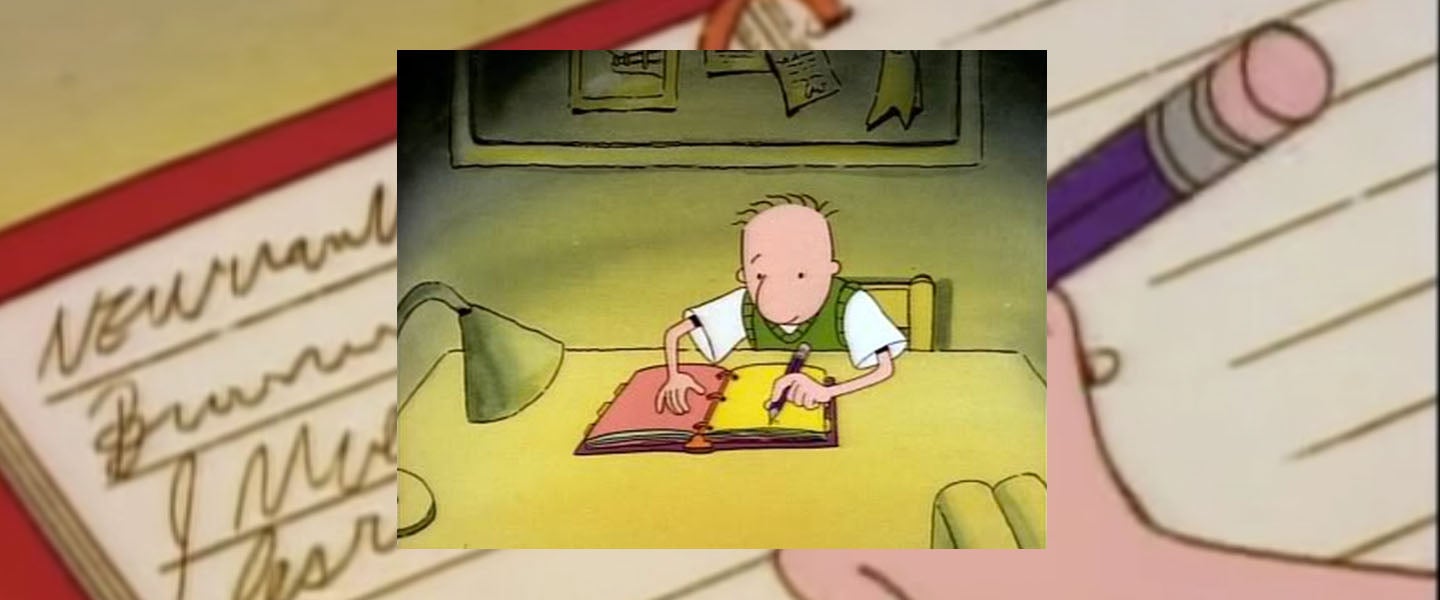Some time in the late 1990s, a prepubescent boy living in the suburbs of L.A. strongly identified with the white, inexplicably balding, eponymous protagonist of the animated TV series Doug. That young boy was not white: He was a light-skinned Persian kid, clumsily flirting with furious concepts like elementary school crushes, “cool versus uncool” and the hex of teenage angst. He was also attending a new school, and though he made friends fairly quickly, he thought of himself as a sanguine loner — often consumed with delusions that made sadness more savory than glee.
Yeah, I was that kid. And Doug Funnie, the cartoon personification of sadboi, was my depressed reflection. Like him, I too lived in a beige stucco suburb that offered little life texture of the kind that sheltered adolescents with festering hormones so often crave.
The most profound feature of a privileged life is the extravagant amount of space and time available to allow oneself to be consumed by coming-of-age phantasmagoria, without any real threats to your existence. A budding, prepubescent mind hungers for drama, so like Doug, I escaped my vanilla reality by daydreaming endless what-if scenarios, a deluge of imagined worst-possible outcomes — a form of low-calorie depression.
One recurring example from this what-if-we-turned-an-Elliott Smith-song-into-a-kid’s-cartoon show that closely echoed my experience was Doug’s crush, Patti Mayonnaise, who liked him but not necessarily in the “like-like” way that feels so life-affirming at that age. In one particular New Year’s Eve episode — which, it should be noted, includes several instances of outright sexual assault on the part of the main bully in the show, who spends the episode kissing girls who don’t want to be kissed but is only ever considered a bit gross as a result — Doug toggles between imagining the most romantic New Year’s Eve kiss with Patti, but also a different imaginary scenario where Patti accuses Doug of being the worst kisser ever. “Where did you learn how to kiss?” she asks. “On a balloon?”
The episode concludes the way most every episode of Doug ends — with a whimper: Patti tells Doug she’s not ready to get into all that “kissing stuff,” and despite the fact that Doug wants nothing more than to kiss Patti, he sullenly agrees. It’s precisely the sort of fizzling finale that makes Doug so goddamn depressing. Sure, one moral of the Doug story is that a khaki-colored life is never quite as bad as your worst nightmare. But the more salient lesson, for me at least, was that that the suburbs are like oatmeal — it’s full of nutrients to keep your hunger at bay, but it lacks the acidity that boyhood craves.
I’m far from the only one who related to the bleak cartoon reality of this 1990s kids show. My colleague Brian VanHooker, an avid Doug fan, agrees that while he didn’t think about it much while he was watching the show, he also latched on to “Doug’s sort of sad isolation.” “I mean, he can’t get the girl, he’s terrorized by bullies, he’s mostly bald and his dog is infinitely cooler than he is,” he reasons. “He’s kind of like Charlie Brown with less friends.”
Another of my colleagues sums up the show’s doom-and-gloom nature by suggesting it’s really about a boy contending with his own mediocrity. “Doug is an 11-year-old balding diarist with a nearly translucent complexion and frequent paranoid delusions,” says Magdalene Taylor, MEL’s editorial assistant. “He’s not someone whose thoughts we want to know, but the entire show is about his inner monologue. It’s a reflection of the anxieties and self-esteem issues of a boy whose primary anxiety is how average he is.”
The self-deprecative, borderline immolative nature of Doug is best understood by the nature of his supposedly “uplifting” imaginations. “Even his superhero alter ego was rather sad,” VanHooker tells me. “Quailman [the character’s superhero alter ego] was just Doug wearing his underwear on the outside and a belt around his head. But these were his FANTASIES! He could have imagined anything, yet all Doug hoped to strive for was this. It kind of shows you what he thinks of himself.”
Others online have put impressive amounts of time and effort into showing just how sad this show truly was. The Tumblr page “Doug Funnie is Crazy” — dedicated to revealing what Doug episodes are really about, told from the point-of-view of his dog — cites itself as, “Devoted to exposing the truth behind the Nickelodeon show. It’s a tragedy, more than a comedy.” There’s also the @DougEpisodes Twitter account, a parodical but apt display of Doug’s persistently depressed mood.
Doug's other car is his drowned son
— Doug Episodes (@DougEpisodes) July 31, 2015
right as his yearbook picture is being taken, a tiny airplane crashes into doug's dick
— Doug Episodes (@DougEpisodes) October 27, 2016
Doug, an adult man, uses the internet to learn that he would have been sorted into Ravenclaw
— Doug Episodes (@DougEpisodes) July 28, 2015
Doug's Science Fair Project is accidentally Eugenics
— Doug Episodes (@DougEpisodes) October 14, 2016
All of which might explain why Disney has no interest in bringing Doug back, according to Jim Jinkins, the show’s creator, as reported in Entertainment Weekly in 2016. Still, Jinkins did admit that he’s “written assorted stories and scenes that would get viewers up-to-date with what Doug Funnie has been up to all these years later,” just in case Disney changes their mind. “I’ve written the scene,” Jinkins tells EW, referring to the one major moment that would answer every fan’s question as to whether Doug and Patti end up together. And of course, never one to diverge from the throngs of disappointing his eternally disappointed audience, Jinkins admits that Doug and Patti don’t end up together. “It doesn’t happen because, really, most people don’t end up with their first love.”
Jesus Christ, that’s sad.

